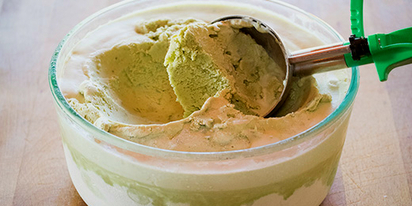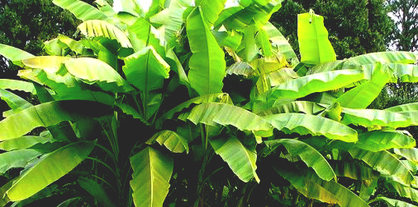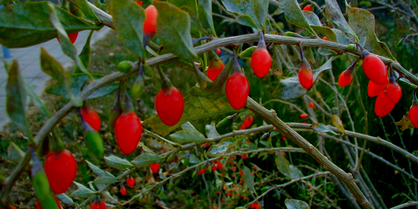
tel: 512 280-1192 Thursday, March 24, 2016
Nursery Notes: Happy Easter everyone! Did you know that
citronella geraniums and lemongrass repel mosquitos? We have
geraniums in 4" pots for $3.59, hanging baskets for $14.99. And
lemongrass 4" pot for $2.59, 1 gal. for $9.99. / All citrus between
$39.99 and $59.99./ Bougainvilleas and hibiscus: $24.99 for 3
gal. Blueberries and blackberries still in stock, along with tons
of tomatoes, cucumbers, squash, eggplant and peppers. We're now
open from 9 a.m. to 6 p.m daily. Please drop by for a visit. Coming
up next weekend: Zilker Garden Festival! 🌿

Thai Basil ice-cream: 'Basil is probably not the first (or tenth,
or even thirty-second) flavor you think of when you think ice
cream,' writes Garden Betty, 'but it’s surprisingly pleasant and
sweet.... Thai basil is 'warmer' than the sweet Italian varieties,
with hints of cinnamon, licorice, and mint. For recipe and com-
plete article, visit Garden Betty 🌿

Basjoo banana plant 'laughs at the cold': if you're looking for
an ornamental banana tree to give your yard a slightly tropical feel,
we recommend this plant. These big, lush beauties, native to the
Ryuku Islands near Japan, reach a height of 10 - 15 feet, and can
grow as far north as Minnesota. Some say the basjoo is cold hardy
down to -20° F when properly mulched. It is best grown in organ-
ically rich, medium moisture, well-drained soil in full sun. They
will however appreciate some part-shade or light-filtered sun in
the heat of the day. We have some for $7.99 in 6.5" pots. 🌿

'Double dig' for better veggie beds: the traditional approach
of turning the top 6 - 8 inches apparently creates havoc with all
of the work of the earthworms, fungi and microbes. This approach
creates an extra deep bed of loose soil, 'without inverting the lay-
Central Texas Gardener: hummingbirds, coralbeam, what to
do with a chinaberry tree, edible weeds with Ellen Zimmerman,
and a visit to designer Amy Voorhes's stylish garden: Sat at 4 p.m
Sun. at 9 a.m. or on-line here: KLRU 🌿

Grow Your Own Goji Berries
by Amanda Moon
a wide range of ailments in traditional Chinese medicine.
This part of the nightshade family has also recently made its way
into western culture due to the high nutritional content of the fruit.
Considered a super-fruit, the goji berry (or 'wolfberry') is a com-
plete protein source, containing all of the amino acids; the berries
are also high in vitamin A and C, fiber and several trace minerals.
This small tart/sweet fruit can make a tasty addition to any salad,
giving it a special sweet crunch. Or just throw them into a smoo-
thie for a nutritious boost. Home-made goji tea and fruit juices are
also possibilities, and the leaves and fresh shoots, which are also
edible, are used in soups and salads in Asia as a green.
___________________________________________________
With the rise in popularity of goji berries over the last 5 years
came the realization for central Texas gardeners that they co
shade family – tomatoes, peppers, eggplant and potatoes – which
many of us plant every year in our home gardens.
However unlike their vegetable siblings, the goji berry is a perenn-
ial here. It can be planted as a loose shrub that will eventually grow
3 to 4 feet high. You can also use it to hang down a retaining wall,
or even as a taller groundcover if left unpruned.
Although the goji berry loses its leaves in the winter here, it emerges
out of dormancy from its branches quite quickly so there's no need
to cut it back to the ground in the fall. The plant roots very easily
from cuttings and may spread in your beds if runners and low hang-
ing stems are left to sit on the ground too long.
It does best in full sun, but the goji can also take part-shade. The
plant starts to bloom small purple flowers in the spring and follows
in the summer with the small, half-inch bright orange berries.
Although quite drought-tolerant, for best fruit-set avoid allowing
it to go entirely dry in the hot months of the summer, because like
other fruit-producing plants they'll drop their flowers and fruit
when stressed.
Aim to keep your goji evenly moist, but have it planted in well-
drained soil. Watering is especially important in the summer be-
cause late summer into early fall is when the berry is harvested.
Goji berries do not require (and won’t tolerate) excessive fertilizer,
but will thrive with an application of seaweed several times through-
out the growing season.
With only a small investment of time and money, the goji berry
is a great addition to any garden. They're nutritious, easy to grow,
and fun for adults and kids alike to harvest and eat straight off of
the plant. A nice, edible treat during the dog days of summer.
Happy easter everyone!
(We have 4.5" pots of goji berries for $3.59 each.)

 🌲 🌿 🌵
🌲 🌿 🌵 Please contact newsletter editor Darrel Mayers
with any ideas for articles or interesting links:
internationalrain@yahoo.com (hitting 'reply' to this email won't work)
Visit the website: Its About Thyme facebook
Visit the nursery: 11726 Manchaca Road, Austin, 78748